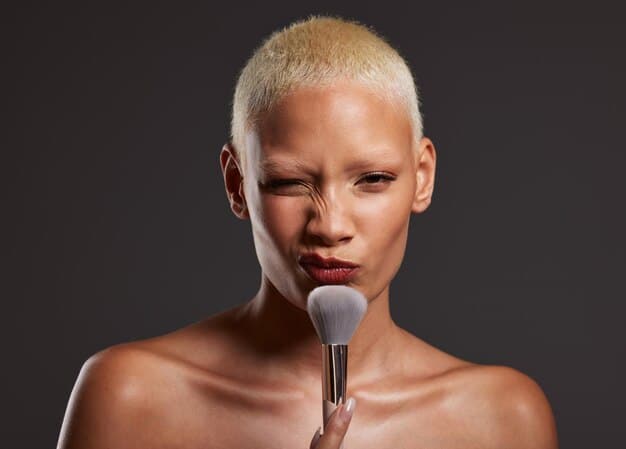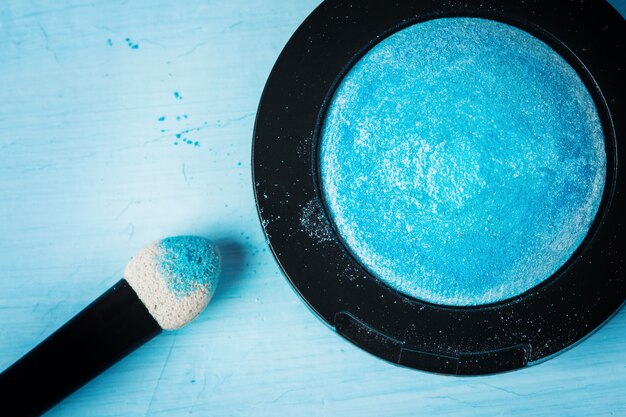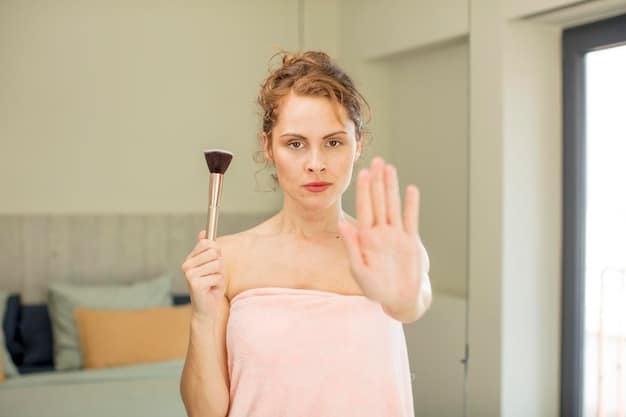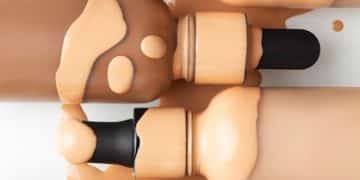The Ultimate Guide to Baking Your Makeup for Long-Lasting Finish

Baking your makeup is a pivotal technique involving applying a thick layer of translucent powder over liquid or cream products and allowing it to set for several minutes before dusting off the excess, creating a matte, creaseless, and exceptionally long-lasting finish essential for 2025’s demanding beauty standards.
In the dynamic world of beauty, achieving a flawless, long-lasting makeup look remains a top priority for enthusiasts and professionals alike. If you’ve ever found your meticulously applied foundation creasing or your concealer fading by midday, then you’re ready to explore an enduring technique. This comprehensive guide, The Ultimate Guide to Baking Your Makeup for a Long-Lasting Finish in 2025, will delve into the timeless art of “baking,” offering insights and updated strategies to ensure your makeup withstands the test of time, humidity, and the rigors of modern life.
The anatomy of “baking”: What it is and why it works
“Baking” in makeup is an application technique that involves applying a generous amount of translucent setting powder over areas of the face where liquid or cream products have been applied, such as under the eyes, on the T-zone, or around the chin. This powder is left to “cook” or “bake” on the skin for several minutes, typically 5 to 10 minutes, allowing the heat from your body to melt the products together and set them in place. The result is an incredibly smooth, creaseless, and long-lasting finish that can withstand extreme conditions.
The effectiveness of baking lies in its ability to securely set cream and liquid products, preventing them from creasing, smudging, or fading throughout the day. By pressing the powder onto these areas, it absorbs excess oils and reinforces the underlying makeup layers. The warmth of the skin helps the powder to meld with the foundation and concealer, creating a seamless, unified base that looks flawless for hours. This technique is particularly beneficial for those with oily skin or anyone needing their makeup to last through long events, humid weather, or demanding schedules.
Historical context and evolution of baking
While “baking” has gained widespread popularity in recent years, particularly through social media and celebrity makeup artists, its origins trace back to the drag community and stage performers who needed their makeup to endure under hot lights and intense physical activity. This technique was essential for maintaining a flawless look that wouldn’t budge, often for hours on end, preventing flashbacks from camera flashes and ensuring a smooth, airbrushed appearance. Over time, it transitioned into mainstream beauty, adapted for everyday use and refined with new product innovations.
The evolution of makeup products, especially finely milled translucent powders, has made baking more accessible and effective for a broader audience. Modern formulas are designed to be lightweight yet powerful, avoiding a heavy or caked-on feeling. As beauty trends continue to emphasize longevity and resilience, baking remains a cornerstone technique for achieving a professional, durable finish. Its adaptability and proven results confirm its position as a go-to method for ensuring makeup longevity.
Essential tools and products for perfect baking in 2025
Achieving a flawless baked finish requires the right arsenal of tools and products. The landscape of beauty in 2025 offers innovative formulations and ergonomic tools that enhance the baking process. Investing in high-quality products specifically designed for this technique can make a significant difference in the final outcome, ensuring your makeup lasts impeccably.
At the heart of the baking process is the translucent setting powder. In 2025, look for powders that are finely milled, lightweight, and non-comedogenic, ensuring they don’t clog pores or settle into fine lines. Many brands now offer powders with added skincare benefits, such as oil-absorbing ingredients like silica or soothing components like green tea extract, catering to various skin types and concerns. The goal is a powder that provides an invisible finish while effectively absorbing excess moisture and oil.
Selecting the right translucent powder
The choice of translucent powder is paramount. While many options exist, focus on those that promise a “blurring” or “soft-focus” effect. These powders often contain light-reflecting particles that minimize the appearance of pores and fine lines, contributing to an airbrushed look. For those with mature skin, opt for powders that are specifically formulated to be non-drying to prevent accentuating wrinkles. Similarly, individuals with acne-prone skin should seek out non-irritating formulas to avoid breakouts.
- Finely milled texture: Essential for a smooth, seamless finish that doesn’t look powdery.
- Translucent (not white): Avoid flashback in photos and ensure compatibility with all skin tones.
- Oil-absorbing properties: Crucial for controlling shine and extending wear time.
Choosing your baking tools: sponges vs. brushes
The application tool also plays a critical role in how well your baking powder adheres and performs. While both sponges and brushes can be used, each offers unique benefits. Makeup sponges, particularly damp beauty blenders, are excellent for pressing the powder firmly into the skin. This pressing motion ensures maximum absorption and a truly locked-in finish. For precise application, especially under the eyes, a mini beauty sponge or a triangular powder puff can be exceptionally useful.
- Damp beauty sponge: Ideal for pressing powder for maximum longevity and airbrushed effect.
- Powder puff: Offers greater control and precision, especially for smaller areas.
- Fluffy brush: Perfect for dusting off excess powder without disturbing the set makeup layer.
For dusting off the excess powder, a large, fluffy powder brush is indispensable. The soft bristles allow you to gently sweep away the unabsorbed powder without disrupting the underlying makeup. Ensure your brush is clean and dry to avoid transferring oils or product residue onto your freshly baked skin. Having a dedicated set of baking tools ensures hygiene and optimal performance every time.
Step-by-step masterclass: How to bake your makeup like a pro
Mastering the art of baking involves precision and understanding each step involved. This detailed masterclass will guide you through the process, ensuring you achieve a professional, long-lasting finish every time. Each stage is crucial for the overall success of the technique, from preparation to the final sweep.
The foundation of any successful makeup application is well-prepped skin. Begin with your regular skincare routine, including cleansing, moisturizing, and priming. A good primer creates a smooth canvas, helping your foundation and concealer adhere better and last longer. Allowing each layer of skincare and primer to fully absorb before moving to makeup ensures a seamless application process.
Step 1: prep your skin and apply base makeup
After your skincare and primer have set, apply your foundation and concealer as usual. For baking, ensure your concealer is applied slightly thicker than usual in the areas you intend to bake, such as under the eyes, around the nose, or on the chin. Blend your cream products thoroughly, ensuring there are no harsh lines or unblended patches. This smooth, even layer is what the baking powder will adhere to, creating a flawless finish.
Once your liquid and cream products are blended, make sure they are not creasing before applying powder. If you have fine lines under your eyes, gently tap excess product with your finger or a sponge to smooth out any creases. This step is crucial because baking will lock in whatever state your makeup is in, including creases. A smooth base ensures a flawless baked result.
Step 2: apply a generous layer of translucent powder

Using a damp beauty sponge or a powder puff, pick up a substantial amount of translucent setting powder. The key here is to be generous; don’t be shy. Gently press the powder onto the areas where you applied concealer and foundation. The pressing motion is vital, as it pushes the powder into the skin and product, ensuring maximum absorption and setting power. Avoid sweeping or rubbing motions, which can disturb your base makeup.
When applying, focus on areas prone to creasing or shine. For most, this means under the eyes, the T-zone (forehead, nose, and chin), and sometimes the smile lines. Apply enough powder so that a visible layer forms on your skin. It should look like a white cast; this is normal and temporary. This thick layer works to absorb oils and seal in your cream products effectively.
Step 3: let it “bake” for optimal setting
Once the powder is applied, let it sit or “bake” on your skin for 5 to 10 minutes. This waiting period allows the warmth of your skin to melt the powder into your foundation and concealer. The longer it sits, the more effectively it absorbs excess moisture and oil, and the more securely your makeup will be set. During this time, you can proceed with other makeup steps, such as eye makeup or eyebrow filling.
The duration of the baking process can vary depending on your skin type and the desired longevity. For extremely oily skin or exceptionally long wear, you might extend the baking time slightly. However, for everyday wear, 5-7 minutes is typically sufficient. Observe how your skin reacts and adjust the timing as needed to achieve your desired matte and smooth finish without looking too dry.
Step 4: gently dust off the excess powder
After the baking period, use a large, fluffy powder brush to gently sweep away any excess powder. Ensure your brush is clean and dry to avoid transferring oils or product residue. Use light, sweeping motions to buff away the remaining powder, revealing a smooth, matte, and creaseless finish underneath. This step is crucial for transforming the white cast into a transparent, flawless layer.
Be thorough but gentle. Over-buffing can disturb your set makeup, while leaving too much powder can result in a powdery or cakey appearance. Your goal is to remove only the unabsorbed powder, leaving behind a perfectly set and airbrushed complexion. Once the excess is removed, you’ll immediately notice the transformation: smoother skin, minimized pores, and a notably long-lasting base.
Advanced baking techniques and tips for 2025
While the basic baking technique offers impressive results, advanced strategies can further refine your application, making it more tailored to specific needs and contemporary trends. In 2025, beauty enthusiasts are seeking innovative ways to enhance longevity and achieve a truly flawless finish. Integrating these advanced tips can elevate your baking game to new heights.
One advanced technique involves “reverse baking” or “under-baking.” This method is particularly useful for those who find traditional baking too matte or drying for their skin type, especially in areas like the cheeks. Instead of applying a thick layer of powder, you can apply a lighter dusting or even use a very fine, setting spray before a minimal amount of powder. This technique still provides setting power but maintains a more natural, radiant finish. It’s about finding the balance between setting and preserving luminosity.
Targeted baking for specific concerns
Baking doesn’t have to be a full-face ordeal. You can adapt the technique to address specific concerns. For instance, if you only experience oiliness around your T-zone, focus your baking efforts solely on your forehead, nose, and chin. Similarly, if creasing under the eyes is your primary issue, concentrate the powder only in that area. This targeted approach saves time and product while delivering precise results where they are most needed.
- Under-eye brightening: Use a slightly brighter shade of translucent powder for an illuminating effect.
- Smile lines: Apply a thin layer of powder directly into the lines after blending concealer.
- Oil control on T-zone: Generously apply and bake powder on the forehead, nose, and chin.
For acne-prone or textured skin, baking can minimize the appearance of pores and imperfections. When applying powder to these areas, use a tapping motion rather than pressing, which can highlight texture. This softer application helps to absorb oil and smooth out the skin surface without emphasizing any raised areas, leading to a more uniform and refined complexion. It’s about leveraging the powder’s characteristics to your advantage.
Combining baking with setting sprays for maximum hold
For ultimate longevity, combining baking with a setting spray is a powerful duo. After you’ve applied and dusted off your baking powder, mist your face with a long-lasting setting spray. The spray helps to melt all the layers of makeup together, creating an even more seamless and budge-proof finish. This step also helps to remove any residual powdery look, making your skin appear more natural and hydrated.
- Layering approach: Bake first, then apply setting spray for a locked-in effect.
- Hydrating sprays: Combat any potential dryness from heavy powder application.
- Oil-control sprays: Enhance the matte finish in extremely oily areas.
Consider using different types of setting sprays based on your desired finish. A matte setting spray will amplify the oil-control benefits of baking, whereas a dewy or hydrating setting spray can reintroduce some luminosity without compromising longevity. This layering strategy ensures multifarious benefits, from extending wear time to perfecting the texture and overall look of your makeup. Always allow the setting spray to dry completely before any further touch-ups.
Common baking mistakes and how to avoid them
While baking is a transformative technique, it’s not without its pitfalls. Novices and even seasoned makeup users can fall prey to common mistakes that undermine the desired flawless, long-lasting finish. Understanding these errors and knowing how to circumvent them is vital for consistently achieving professional-level results in 2025’s sophisticated beauty landscape.
One of the most frequent errors is applying too much powder without adequately preparing the base. If your foundation and concealer aren’t fully blended or have settled into fine lines before baking, the powder will simply amplify these imperfections. A smooth, creaseless canvas is essential. Always ensure your liquid and cream products are perfectly blended and free of creases before you even think about reaching for the powder.
Mistake 1: applying powder over unblended or creased makeup
Applying powder over unblended or creased foundation and concealer is like cementing a mistake. Once the powder sets, any underlying unevenness or lines will be locked in place, making them much harder, if not impossible, to fix without removing and redoing your makeup. Take the time to ensure your base products are seamlessly blended, and gently tap out any creases under the eyes or around the mouth before applying powder.
The goal of baking is to perfect and set, not to hide or fix poor initial application. Think of it as enhancing an already good base. By ensuring a smooth, even layer of liquid or cream product, the translucent powder can then effectively blur and absorb excess oils, resulting in a truly flawless and long-lasting finish that reflects expertise and attention to detail, characteristic of makeup trends in 2025.
Mistake 2: using too much powder or the wrong type of powder
While baking requires a generous amount of powder, there’s a fine line between enough and too much. Excessive powder, especially one that isn’t finely milled or truly translucent, can leave a visible white cast, emphasize texture, or make your skin look dry and cakey. This is particularly problematic in photos due to flashback. Always choose a finely milled, truly translucent powder designed for setting.

Moreover, using a powder that is too heavy or doesn’t suit your skin type can lead to undesirable effects. For dry skin, a very mattifying powder might cause flakiness. For mature skin, heavy powders can settle into fine lines, making them more apparent. Always consider your skin’s unique needs when selecting your baking powder and adjust the quantity accordingly to achieve a balanced, comfortable, and beautiful result.
Mistake 3: not letting the powder “bake” long enough or letting it too long
The “baking” time is crucial. Not allowing the powder enough time to fuse with your skin and underlying products means it won’t fully absorb excess oils or set properly, leading to a less durable finish. On the other hand, leaving the powder on for an excessively long period can lead to over-drying, particularly for those with dry or combination skin, resulting in an unnatural, overly matte, or even patchy appearance.
The optimal baking time (typically 5 to 10 minutes) strikes a balance between effective setting and maintaining a natural appearance. Experiment to find what works best for your skin type and the specific products you’re using. If you have very oily skin, you might benefit from slightly longer baking, while drier skin types might need a shorter duration. Observing your skin’s reaction is key to perfecting your baking technique and avoiding common pitfalls.
New trends and innovations affecting baking in 2025
The beauty industry is in a constant state of evolution, and 2025 is no exception. New trends and technological advancements are continually reshaping makeup techniques, including baking. Staying informed about these innovations allows you to adapt your routine and leverage the latest products for superior results.
One significant trend influencing baking is the move towards “skinimalism” and a more natural, yet perfected, skin finish. While baking provides unparalleled longevity, there’s a growing demand for techniques that don’t compromise skin’s natural radiance. This has led to the development of micro-fine setting powders and hybrid formulas that offer setting power without a heavy, matte appearance, blurring the lines between traditional baking and everyday wear.
Hybrid powder formulations and smart tools
In 2025, expect to see an increase in hybrid powder formulations that offer more than just setting. These powders may include skincare benefits like hydration, anti-pollution properties, or even SPF. Such innovations allow for a more holistic approach to makeup, where products not only enhance appearance but also contribute to skin health. The goal is to provide a long-lasting finish that feels comfortable and nourishing.
- Skincare-infused powders: Offer hydration and soothing benefits alongside setting power.
- SPF powders: Provide sun protection while setting makeup, ideal for daily use.
- Blurring and perfecting powders: Utilize advanced silicone technology for a smooth, pore-less finish.
Smart tools are also transforming the baking process. Expect to see smart devices that assist in precise powder application, ensuring even distribution and optimal product use. These innovations might include smart sponges with temperature control for enhanced product melding, or precise applicators that automatically dispense the perfect amount of powder. Such tools aim to simplify the technique, making professional-level baking accessible to everyone.
Sustainability and clean beauty in baking products
The increasing consumer demand for sustainable and clean beauty products is strongly impacting the development of baking powders and tools. Brands are focusing on ethically sourced ingredients, eco-friendly packaging, and manufacturing processes with a reduced environmental footprint. This shift means that in 2025, you’ll find more baking products made with responsibly harvested ingredients, free from harmful chemicals, and housed in recyclable or refillable containers.
- Refillable powder compacts: Minimize waste and promote conscious consumption.
- Vegan and cruelty-free formulas: Align with ethical consumer values.
- Biodegradable applicators: Sponges and puffs made from sustainable materials.
This focus on sustainability extends beyond the product itself to the entire supply chain. Consumers are becoming increasingly aware of the environmental and social impacts of their purchases, driving brands to innovate in a more responsible manner. Choosing baking products from brands committed to clean beauty and sustainability not only supports these values but also typically ensures high-quality ingredients that are better for your skin and the planet.
Maintaining your baked look throughout the day
Baking is exceptional for creating a long-lasting base, but even the most perfectly baked makeup can benefit from some strategic maintenance throughout the day. Humidity, oil production, and environmental factors can all impact the longevity of your look. Knowing how to touch up your makeup without disturbing the baked finish is key to maintaining a flawless complexion from morning until night.
The first rule of maintaining your baked look is to avoid over-touching your face. Frequent touching can transfer oils, disrupt the makeup layers, and cause creasing. If you find yourself in a situation where you need to blot, use a tissue or blotting paper to gently press and lift away excess oil, rather than rubbing. This preserves the matte finish and prevents shine without disturbing your base.
Strategic touch-ups for lasting perfection
When touch-ups are necessary, approach them strategically. For oiliness, blotting papers are your best friend. They absorb excess oil without adding more product, which can lead to a cakey look. If you need to refresh your makeup, a light dusting of translucent powder, applied sparingly with a fluffy brush, can help. Focus on areas that tend to get shiny, like the T-zone.
For mild creasing, particularly under the eyes, gently tap the area with a clean finger or a small, damp sponge to smooth out the product before applying a tiny amount of powder. This technique re-sets the makeup without adding unnecessary layers. Remember, less is often more when it comes to midday touch-ups, ensuring your baked look remains fresh and natural.
Using refreshing mists and blotting products
Refreshing mists can be highly effective in revitalizing your baked makeup without adding more product. A hydrating or setting mist can reintroduce a subtle luminosity to your skin, making it look fresh and less matte if desired. These mists can also help to fuse any touch-up products with your existing makeup, ensuring a seamless finish.
- Blotting papers: Essential for quickly absorbing excess oil without disturbing makeup.
- Mini powder puff: For targeted, light powder touch-ups on oily areas.
- Hydrating mists: Rehydrate the skin and refresh the overall makeup look.
Carry a small compact of translucent setting powder and a mini powder puff for on-the-go touch-ups. This allows you to quickly address any shine or minor creasing that may appear. The key is to apply powder only where needed and in small amounts to avoid building up too much product. With these simple strategies, your perfectly baked makeup will remain impeccable throughout the day, embodying the durability and flawless finish that the technique is celebrated for.
| Key Aspect | Brief Description |
|---|---|
| ✨ Technique Overview | Apply generous translucent powder, let it “cook” with body heat (5-10 min), then dust off for a matte, creaseless finish. |
| 🛠️ Essential Tools | Finely milled translucent powder, damp beauty sponge or powder puff, and a large fluffy brush. |
| ❌ Common Mistakes | Applying over creases, using too much or wrong powder, incorrect baking time. |
| 💡 2025 Innovations | Hybrid powders (skincare-infused), smart application tools, and sustainable options. |
Frequently asked questions about makeup baking
▼
The primary benefit of baking makeup is achieving an exceptionally long-lasting, creaseless, and matte finish. It significantly extends the wear of liquid and cream products by allowing translucent powder to absorb excess oils and set the makeup firmly in place, preventing smudging and fading throughout the day.
▼
Yes, baking can make your makeup look cakey if not done correctly. Common reasons include applying powder over unblended or creased makeup, using too much powder, or selecting a powder that is too heavy or not finely milled. Proper technique, including gentle blending and appropriate product selection, is key to avoiding a cakey finish.
▼
While baking is highly effective for oily and combination skin types due to its oil-absorbing properties, it can be adapted for drier skin. Those with dry or mature skin should use a lighter hand, a hydrating setting powder, and may benefit from “reverse baking” or shorter baking times to avoid over-drying or accentuating fine lines.
▼
The ideal baking time is typically between 5 to 10 minutes. This duration allows sufficient time for the translucent powder to interact with the natural warmth of your skin and underlying makeup, effectively absorbing oils and setting the products. Adjusting the time based on your skin type and desired level of longevity is recommended.
▼
After letting your makeup bake, use a large, fluffy, and clean powder brush to gently sweep away any excess product. Use light, sweeping motions to avoid disturbing the set makeup beneath. A clean brush is crucial to prevent transferring oils or unevenly distributing the powder, ensuring a smooth, airbrushed finish.
Conclusion
Baking your makeup is more than just a passing trend; it’s a strategic technique that has proven its worth in delivering a flawless, long-lasting finish. By understanding its scientific basis, utilizing the right products and tools, and refining your application through practice, you can transform your makeup routine. As we move through 2025, embracing new innovations, while avoiding common pitfalls, will ensure your baked look remains fresh, matte, and absolutely impeccable throughout the day, providing confidence and a perfected appearance that stands the test of time.





